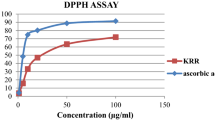Abstract
Zingiber moran (Zingiberaceae) has long been used as a folk medicine. In the current study, the essential oil was extracted from the dried rhizomes using hydrodistillation and was subjected to fractionation using thin-layer and column chromatography. Three major fractions were characterized using NMR, FTIR, and mass spectroscopy studies and were identified as terpenoids namely camphene, citral, and linalool. The in vitro cytotoxic studies using HeLa cell line revealed the significant cytotoxic activity of these compounds. The cell viability (%) was determined by MTT assay and subsequently the IC50 values were calculated to be 38.54, 39.65, and 55.44 μg/ml for camphene, citral, and linalool, respectively. Further, inverted light microscopy observations along with live dead staining assay of treated cells revealed a significant dose-dependent effect of these compounds on the cell morphology and death, where it was found that the HeLa cells were prone to apoptosis at lower doses and necrosis at higher doses. The findings reveal promising scope of the endemic ginger to be used as a potential source of medicine.



Similar content being viewed by others
References
Abdul ABH, Al-Zubairi AS, Tailan ND, Wahab SIA, Zain ZNM, Ruslay S, Syam SS (2008) Anticancer activity of natural compounds (zerumbone) extracted from Zingiber zerumbet in human HeLa cervical cancer cells. Int J Pharmacol 4:160–168
Chairgulprasert V, Prasertsingskun S, Wichaporn W (2005) Chemical constituents of the essential oil and antibacterial activity of Zingiber wrayi var. halabala. Songklan. J Sci Technol 27:813–818
Chien TY, Chen LG, Lee CJ, Lee FY, Wang CC (2008) Anti-inflammatory constituents of Zingiber zerumbet. Food Chem 110:584–588
Fabricant DS, Farnsworth NR (2001) The value of plants used in traditional medicine for drug discovery. Environ Health Perspect 109:69–75
Gopinath P, Ghosh SS (2008) Apoptotic induction with bifunctional E. coli cytosine deaminase-uracil phosphoribosyltransferase mediated suicide gene therapy is synergized by Curcumin treatment in vitro. Mol Biotech 39:39–48
Hiserodt RD, Franzblau SG, Rosen RT (1998) Isolation of 6-, 8-, and 10 gingerol from rhizome by HPLC and preliminary evaluation of inhibition of Mycobacterium avium and Mycobacterium tuberculosis. J Agric Food Chem 46:2504–2508
Khine MM (2006) Isolation and characterization of phytoconstituents from Myanmar medicinal plants. Ph.D. Thesis, Myanmar, Yangon University. URL http://sundoc.bibliothek.uni-halle.de/diss-online/06/06H045/t1.pdf. Accessed July 2012
Mau JL, Lai EYC, Wang NP, Chen CC, Chang CH, Chyau CC (2003) Composition and antioxidant activity of the essential oil from Curcuma zedoaria. Food Chem 82:583–591
Natta L, Orapin K, Krittika N, Pantip B (2008) Essential oil from five Zingiberaceae for anti food-borne bacteria. Int Food Res J 15:337–346
Nnadozi K, Sodipo Amoo V, Cragg G, Keller M, Artuso A (2000) GBDI/IITA biodiversity, biotechnology and law training course, West Africa, pp 5–7
Oetari S, Sudibyo M, Commandeur JN, Samhoedi R, Vermeulen NP (1996) Effects of curcumin on cytochrome P450 and glutathione S-transferase activities in rat liver. Biochem Pharmacol 51:39–45
Policegoudra RS, Aradhya SM (2007) Biochemical changes and antioxidant activity of mango ginger (Curcuma amada Roxb.) rhizomes during postharvest storage at different temperatures. Postharv Biol Technol 46:189–194
Purkayastaha J, Nath SC, Klinkby N (2006) Essential oil of the rhizome of Curcuma zedoaria (Christm.) Rosc. native to Northeast India. J Essen Oil Res 18:154–155
Radhika NK, Sreejith PS, Asha VV (2010) Cytotoxic and apoptotic activity of Cheilanthes farinose (Forsk) Kaulf. against human hepatoma, Hep3B cells. J Ethnopharmacol 128:166–171
Singh NP, Singh KP, Singh DK (2002) Flora of Mizoram, vol 1. Botanical Survey of India, Ministry of Environment & Forests, GOI, Kolkata, pp 1–26
Singh G, Kapoor IPS, Singh P, de Heluani CS, de Lampasona MP, Catalan CAN (2008) Chemistry, antioxidant and antimicrobial investigations on essential oil and oleoresins of Zingiber officinale. Food Chem Toxicol 46:3295–3302
Srivastava P, Kasoju N, Bora U, Chaturvedi R (2009) Dedifferentiation of leaf explants and cytotoxic activity of an aqueous extract of cell cultures of Lantana camara L. Plant Cell Tiss Organ Cult 99:1–7
Yang X, Eilerman RG (1999) Pungant principle of Alpinia galangal (L.) Swartz and its applications. J Agric Food Chem 47:1657–1662
Yang Z, Luo S, Peng Q, Zhou C, Yu Z (2009) GC-MS analysis of the essential oil of coral ginger (Zingiber corollinum Hance) rhizome obtained by supercritical fluid extraction and steam distillation extraction. Chromatography 69:785–790
Zwaving JH, Bos R (1992) Analysis of the essential oil of five Curcuma species. Flav Fragr 7:19–22
Acknowledgments
AD and NK thanks Ministry of Human Resources Development (MHRD), Government of India for fellowship. Authors thank CIF (IITG) for nuclear magnetic resonance and mass spectroscopy analysis. LR acknowledges funding by the Department of Information Technology, Ministry of Information Technology, Government of India (DIT Grant No. DIT No: 0526/T/IITG/014/0809/38).
Author information
Authors and Affiliations
Corresponding author
Electronic supplementary material
Below is the link to the electronic supplementary material.
44_2012_432_MOESM1_ESM.docx
TLC plate showing the three single spots obtained from repeated column chromatography of Z. moran rhizome essential oil. (DOCX 186 kb)
44_2012_432_MOESM8_ESM.docx
Inverted fluorescence microscopic images of treated and untreated HeLa cells after staining with AO/EB (400X) (DOCX 870 kb)
Rights and permissions
About this article
Cite this article
Das, A., Kasoju, N., Bora, U. et al. Chemico-biological investigation of rhizome essential oil of Zingiber moran—native to Northeast India. Med Chem Res 22, 4308–4315 (2013). https://doi.org/10.1007/s00044-012-0432-0
Received:
Accepted:
Published:
Issue Date:
DOI: https://doi.org/10.1007/s00044-012-0432-0




